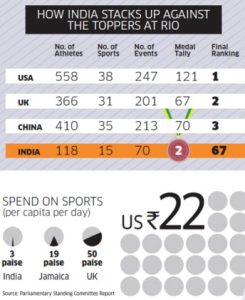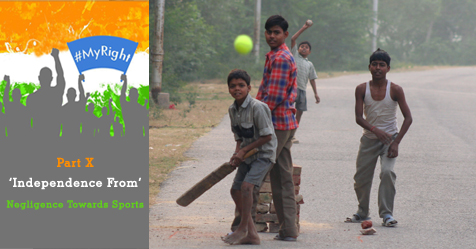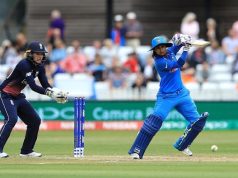MyRight: Independence From Negligence Towards Sports
In the 2016 Rio Olympics, shuttler PV Sindhu became the first Indian woman to win a silver medal; Sakshi Malik the first Indian female wrestler to win a medal (bronze), gymnast Dipa Karmarkar became the first Indian woman to feature in a gymnastics final, finishing fourth, and Lalita Babar became the first Indian woman to enter a 3,000 m steeplechase final, finishing 10th. Eighteen-year-old Aditi Ashok–the youngest golfer from India–also entered the final round of the women’s individual golf event.
The growing presence of women was reflected in the 53 female Indian athletes–the largest number ever–at the 31st Olympiad.
The declining attention towards women sports is a troublesome situation. This neglect is world over, and especially in developing countries like India, where women are yet to achieve equal status in many areas. Female athletes have subjugated by marginal exposure in sport settings and mainstream media.
The government has spelled out that social welfare expenditure by companies towards promotion of sports like the rural and Olympic sport will be considered as a CSR activity. Under the new Companies Act, certain entities, which fall under the parameters, are required to spend at least two per cent of their three-year annual average net profit towards Corporate Social Responsibility (CSR) activities. Schedule VII of the Companies Act, 2013 that indicates a list of CSR activities includes training to promote rural sports, nationally recognised sports and Olympic sports.
“The inclusion of sport under the CSR mandate has significantly benefited organisations such as ours. Due to excellent backing by our corporate donors, we have been given opportunities to meaningfully impact and positively alter the lives of our athletes via our athlete development programmes. Our corporate partners, who have backed the niche of sporting excellence in India through our programmes, are not only transforming the lives of athletes but are also helping to create a ripple effect and turn the same athletes into role models for future generations.” says Deepthi Bopaiah, Executive Director, GoSports.

Courtesy: Economic Times
Ground realities
Sakshi Malik hailing from Haryana, is a state with the worst sex ratio in the country (879 women for every 1,000 men). Haryana’s child sex ratio (0-6 years old) is even lower and the poorest in the country at 834, according to Census.
This gloomy image suggests that Haryana’s overall sex ratio will only decline further in the years ahead. Would Malik’s success be achieved despite the prevailing situation in her state?
On the other hand, starting an academy for Pullela Gopichand wasn’t easy. In 2003, the Andhra Pradesh government, as a token of appreciation for his All-England triumph in 2001, allotted five acres of land to Gopichand to build his academy, the onus of raising the Rs 13 crore he needed to set it up, was entirely Gopi’s responsibility. Several corporate houses that Gopi approached, discussed and deliberated but did not pitch in. He finally mortgaged his house to raise Rs 3 crore and industrialist Nimmagadda Prasad donated Rs 5 crore.
“Our country may have won only 2 medals at the Olympics, but a number of Indian athletes almost made it to podium finishes, which is heartening to note. Dipa Karmakar’s efforts at the Olympics, for example, are now inspiring an entire generation to think of gymnastics as a sport where India can win medals! We are firm believers that India holds immense sporting potential, which will only be harnessed if we take steps as a society to change the way that sport is supported,” highlights Bopaiah.
Prevailing scenario
There is plenty chatter about the lack of a sporting “culture” or “ethos”, and we should work to build one if we want better results. The underlying question is what does it really mean? Do other countries have such an ethos? If so, how did they develop it? How will we know when we have one?
 One has to focus and understand how race, class, gender, and other forms of repression shape women’s professional sport and the kind of change the support of corporate social responsibility (CSR) and mainstream media coverage it brings about. Research on development of sports and role of women in sports, will permit professional leagues and teams to move forward with a more informed perspective regarding the overall purpose of CSR in women’s professional sport.
One has to focus and understand how race, class, gender, and other forms of repression shape women’s professional sport and the kind of change the support of corporate social responsibility (CSR) and mainstream media coverage it brings about. Research on development of sports and role of women in sports, will permit professional leagues and teams to move forward with a more informed perspective regarding the overall purpose of CSR in women’s professional sport.
In the end, it is important because CSR initiatives can serve as a way to connect with the community, highlight socially relevant issues and make athletes as role models for youth. Gender discrimination in sports negatively impacts the level of interest.
Due to continuing discriminatory ways, the opportunity to organise meaningful outreach to young women and girls are weakened. Companies must take up CSR activities to eliminate such evils from the society. Increased support need to be provided to existing academies and institutions. More importantly, it is the need of the hour to urgently shift the mindset in society. We should support rather than just applaud. The support to regularly play for an hour, and not remark it an act to pass time or regard it as insignificant. The focus point here is the school of thought, which in turn increases participation and improved change in quality of representation leading to a boost in the medal basket. Let us become a better sporting society.
Thank you for reading the story until the very end. We appreciate the time you have given us. In addition, your thoughts and inputs will genuinely make a difference to us. Please do drop in a line and help us do better.
Regards,
The CSR Journal Team













